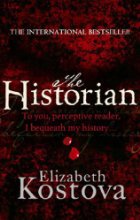 The Historian by Elizabeth Kostova
The Historian by Elizabeth Kostova
Paperback: 704 pages
Publisher: Back Bay Books (October 1, 2006)
ISBN-10: 0316154547
The Historian is the debut novel from Elizabeth Kostova. I read this novel a couple of years back when it first came out. I was working in a bookstore at the time, and I remember picking this book up and reading the back of it and thought it sounded interesting. The novel is somewhat of a blend of several genres: historical fiction, suspense, thriller, mystery, and vampire lore.
The storyline opens in 1972 in Amsterdam, centering on a teenage girl who is going through her father’s library and discovers a medieval book with a woodcut of a dragon inside along with a pile of old letters, addressed to “my dear and unfortunate successor.” The girl asks her father, Paul, about these letters, and he relates to his daughter how twenty years ago he had been involved in a search for his graduate school mentor, Professor Rossi, a man who had spent his life researching and studying Vlad Dracula, or Vlad the Impaler, a medieval ruler in southern Romania who was known for torturing his enemies by impaling them on wooden stakes.
Out of this historical figure, the myth of Dracula arises, and the reader is swept across Europe and through history in search for the legendary Vlad the Impaler. One of Kostova’s greatest strengths as a writer is her ability to describe the European landscape, and if you enjoy travel, you’ll certainly love how this novel carries you all throughout Eastern Europe. Her imagery is beautiful, and for this reason, I would recommend reading the book more than once.
You might also have to read it more than once to understand all the criss-crossing story lines, as the narrative takes place in three different time periods: in 1930, when Professor Rossi begins his research on Dracula, in 1950, when Paul begins his search for Professor Rossi, and in 1972, where the main narrative lies with the teenage daughter.
The novel is written in first person, and most of the story is told through the letters that the daughter is reading; these letters are mostly from her father, so you see a majority of the novel from Paul’s perspective. For this reason, I did not feel a strong connection to the teenage daughter, and I actually found her character kind of flat. Paul’s character is strong, and he shines as the protagonist, and I felt the other supporting characters were strong as well.
The ending, like the teenage daughter’s character, falls flat as well and comes off uninspired, and if not for the bizarre revelation at the story’s climax, I would have given this novel five stars. As such, I am inclined to only give it four stars, but honestly, you’ll be so captivated by the beautifully detailed European landscape, the suspenseful story lines, and the rich history that you’ll want to read it again.
My rating: 4 stars
Interesting. I had not heard of this book before.
Years ago when I was in high school I did a research paper on vampires and discovered all kind of strange vampire lore. Was there any mention in this book of Reverend Montague Summers or Elizabeth Bathory?
McCabe, there wasn’t any mention in the Historian — from what I remember — of the two people you mention. Who are they?
I’m afraid I found most of the book flat, not just the ending. Not one of my favourites!
Carla, was there a particular aspect you found flat (characters, storyline, writing style, etc.) or was it a bit of everything? I can understand how readers could think that. I know many share that opinion.
I love the story of Elizabeth Bathory =]
I am a BIG vampire story lover
http://en.wikipedia.org/wiki/Elizabeth_Bathory
I’m not familiar with Elizabeth Bathory. Thanks for sharing the link, Soul Alight. Come back again and comment some time.